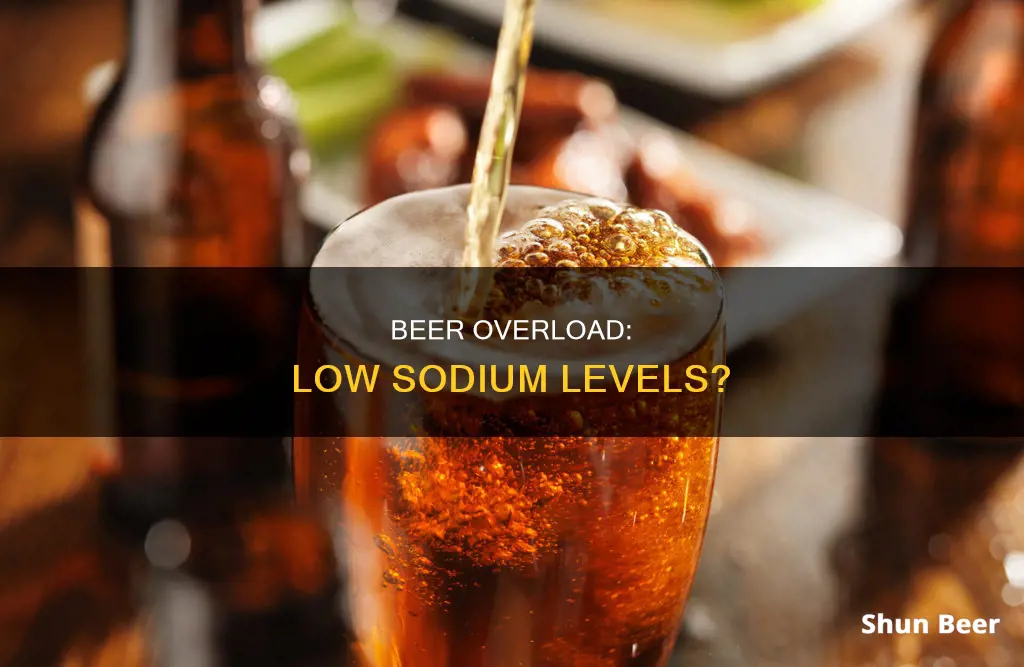
Drinking too much beer can lead to a condition called beer potomania, which is characterised by abnormally low sodium levels in the blood, also known as hyponatremia. This occurs when excessive beer consumption, combined with poor nutritional intake, results in a significant drop in sodium levels. The condition was first reported in 1972 and can have severe health consequences, including neurological impairment and seizures. Treatment for beer potomania requires a delicate approach, as rapid correction of sodium levels can lead to osmotic demyelination syndrome, a serious neurological disorder. Prevention involves maintaining a healthy diet and reducing alcohol intake.
| Characteristics | Values |
|---|---|
| What is it called? | Beer potomania, beer drinker's hyponatremia |
| What does it mean? | Excessive beer consumption leading to low sodium levels in the blood |
| What are the symptoms? | Acutely altered mental state, muscle weakness, spasms or cramps, loss of energy or fatigue, irritability or restlessness, nausea or vomiting, headache, seizures, coma |
| What are the complications? | Cerebral edema, coma, brainstem herniation, seizures, pulmonary aspiration, falls, death |
| What is the treatment? | No food or drink except medicines for 24 hours, IV fluids if needed, regular monitoring of sodium levels, oxygen as needed |
| How can it be prevented? | Eating healthy and nutritious meals, reducing or avoiding alcohol intake |
What You'll Learn

Beer potomania
The syndrome of beer potomania occurs when an individual consumes excessive amounts of beer while also having poor dietary habits, particularly a low intake of solutes (electrolytes and proteins). Beer has a high water content and a low sodium content, which, when consumed in large quantities, can dilute the sodium in the body, making it ineffective. This results in a condition called hyponatremia, where the sodium levels in the blood become abnormally low.
The symptoms of beer potomania often occur after a binge-drinking episode and can include an altered mental state, muscle weakness, spasms, fatigue, irritability, restlessness, nausea, vomiting, headaches, seizures, and even coma. These symptoms are related to the decrease in electrolytes, particularly sodium, potassium, and magnesium. The severity of symptoms is directly linked to the rapid drop in sodium levels, which can lead to cerebral overhydration and neurological impairments.
The treatment of beer potomania requires a delicate approach to avoid complications. Rapid correction of sodium levels can lead to neurological problems such as osmotic demyelination syndrome (ODS). Therefore, doctors recommend a slow and careful administration of sodium over 48 hours, along with intensive care and frequent monitoring of sodium levels.
To prevent beer potomania, it is crucial to maintain a healthy and nutritious diet, including all the major food groups, and to reduce or avoid excessive alcohol consumption.
Enjoying Beer While Watching Champions League Games
You may want to see also

Hyponatremia
The syndrome gets its name from the combination of "poto," meaning drinking, and "mania," meaning excessively. Beer contains a high water content and a low sodium content. When consumed in excess, especially when coupled with a diet lacking in sodium and protein-rich foods, it can lead to dangerously low sodium levels in the blood. This is because the kidneys require a certain amount of sodium to function properly. Without sufficient sodium, the kidneys are unable to clear excess fluids from the body, leading to a buildup of fluid in the blood and resulting in cellular swelling.
The symptoms of beer potomania often occur after a binge-drinking episode and can include an altered mental state, muscle weakness, spasms or cramps, fatigue, irritability, restlessness, nausea, vomiting, headaches, seizures, and even coma. The severity of symptoms is directly related to the severity of cerebral overhydration, which is influenced by the degree of hyponatremia.
Treating beer potomania requires a cautious approach. While increasing sodium levels may seem like an obvious solution, doing so too rapidly can lead to neurological problems such as osmotic demyelination syndrome (ODS). ODS can cause serious neurological issues, including spasms, severe mental impairment, and coma. Therefore, doctors recommend slowly administering sodium over a 48-hour period.
To prevent beer potomania, it is crucial to maintain a healthy and nutritious diet while reducing or avoiding alcohol intake. A balanced diet should include fruits, vegetables, low-fat dairy products, lean proteins, and healthy fats. Additionally, managing alcohol addiction is essential, as beer potomania is just one of the many life-threatening conditions that can arise from alcohol abuse.
Understanding Sobriety: Non-Alcoholic Beer's Impact
You may want to see also

Electrolyte abnormalities
Hyponatremia is the most frequent electrolyte abnormality in hospitalised patients, with a prevalence of up to 40% in all hospitalised patients and up to 30% in specialised units. It is associated with many clinical conditions and may occur in the presence of hypovolemia, euvolemia, or hypervolemia. In patients with normal renal function, excessive water ingestion does not usually result in severe hyponatremia because the kidneys can excrete large amounts of free water. However, when someone consumes large amounts of beer, which has a low solute content, and does not ingest enough other solutes, it can result in severe hyponatremia.
The treatment of beer potomania can be challenging. It is important to correct sodium levels slowly and carefully to prevent a condition called osmotic demyelination syndrome (ODS), which can permanently affect the nervous system. In some cases, this can be life-threatening. Nursing care for patients with beer potomania includes obtaining an accurate history, judicious sodium correction, and close monitoring of the patient's sensorium, neurological status, and fluid and electrolyte balance.
Beer and Kidney Health: What's the Connection?
You may want to see also

Alcohol use disorder
Drinking too much beer can cause low sodium levels in the body, a condition known as "beer potomania" or "beer drinker's hyponatremia". Hyponatremia is the medical term for abnormally low sodium levels in the blood, which can be caused by excessive water consumption, a common issue among people who misuse alcohol. Beer contains a lot of water and very little sodium, which can lead to a dangerous drop in sodium levels, especially when combined with a low intake of sodium and protein-rich foods. This condition is often seen in people with alcohol use disorder.
People with AUD may exhibit several behavioural and mood changes, such as craving alcoholic beverages, continuing to drink despite negative consequences, drinking more than intended, spending excessive time obtaining or recovering from alcohol, failing to meet obligations, giving up important activities, and using alcohol in hazardous situations. They may also experience withdrawal symptoms when they try to reduce their alcohol intake.
The causes of AUD are multifaceted and not fully understood. However, research has identified several risk factors, including genetics and mental health conditions. Individuals with a family history of AUD have an increased risk, and those with conditions like depression, post-traumatic stress disorder (PTSD), or attention-deficit/hyperactivity disorder (ADHD) may be more susceptible.
Treatment for AUD typically involves a combination of medication and behavioural therapy. While relapses may occur, studies indicate that most individuals can successfully reduce their alcohol consumption or achieve abstinence with appropriate treatment. Support groups and counselling can also provide valuable support during the recovery process.
Troubleshooting a Beer Siphon: What You Need to Know
You may want to see also

Osmotic demyelination syndrome
Drinking too much beer can cause low sodium levels, a condition known as "beer potomania" or "beer drinker's hyponatremia". Hyponatremia is the medical term for an abnormally low sodium level in the blood. Beer contains a lot of water and only a small amount of sodium, which can lead to water intoxication and cause a range of symptoms, including altered mental state, muscle weakness, spasms, fatigue, irritability, and even coma.
Now, let's discuss osmotic demyelination syndrome (ODS) in detail:
Symptoms and Diagnosis:
The clinical presentation of ODS varies and may include encephalopathy, dysphagia, dysarthria, pseudobulbar palsy, quadriparesis, dystonia, Parkinsonism, and locked-in syndrome. Diagnosis is often made through neurological examination, laboratory tests, and neuroimaging, particularly magnetic resonance imaging (MRI) of the brain. MRI findings suggestive of ODS include hyperintense lesions within the pons, basal ganglia, and thalami.
Treatment and Prognosis:
There is no definitive treatment for ODS, and the management focuses on supportive care and addressing the underlying causes. Dopamine agonists and other anti-dystonic medications have shown some promise in treating extrapyramidal features associated with ODS. Plasmapheresis, a procedure that involves removing, treating, and returning plasma to the bloodstream, has also been used to treat ODS in some cases.
The prognosis for ODS varies, and full clinical recovery is possible in some cases. However, many patients who survive ODS are left with long-term neurological deficits and may require extensive neurorehabilitation. Therefore, prevention is crucial, and healthcare providers should be cautious when correcting hyponatremia to avoid rapid increases in sodium levels, which can trigger ODS.
Babies and Beer: Is It Ever Safe?
You may want to see also
Frequently asked questions
Drinking too much beer refers to excessive or binge drinking over a long period. This, coupled with poor nutritional intake, can lead to a condition known as "beer potomania" or "beer drinker's hyponatremia".
Beer contains a lot of water and very little sodium. When consumed excessively, especially with inadequate sodium and protein-rich food intake, the body's sodium levels can drop dangerously low, resulting in a condition called hyponatremia.
Symptoms of beer potomania include acutely altered mental state, muscle weakness, spasms or cramps, loss of energy or fatigue, irritability or restlessness, nausea, vomiting, headache, seizures, and even coma.
Treatment for beer potomania involves careful monitoring and slow correction of sodium levels over 48 hours to avoid complications such as osmotic demyelination syndrome (ODS), which can have serious neurological consequences.
To prevent beer potomania, it is essential to maintain a healthy and nutritious diet, ensuring adequate sodium and protein intake. Reducing alcohol consumption or seeking help for alcohol addiction is also crucial.







